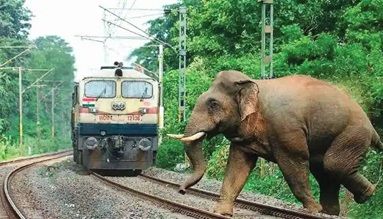The Northeast Frontier Railway (NFR), which operates in the northeastern states and in seven districts of West Bengal and five districts of north Bihar, has introduced an Artificial Intelligence based surveillance mechanism in elephant corridors to prevent elephant deaths due to train hits.
The NFR recently signed a Memorandum of Understanding (MoU) with RailTel Corporation of India Ltd, for installation of Intrusion Detection System (IDS) to avert train-elephant collision and have disaster mitigation measures.
NFR Chief Public Relations Officer Sabyasachi De said that the Railways has been taking many initiatives to prevent and detect movement of wild animals, especially elephants, approaching the tracks. Installation of IDS in important sections is one such measure.
After 100 per cent success of the pilot project on IDS that was undertaken by the NFR in the Chalsa – Hasimara section of the Dooars area under Alipurduar Division in West Bengal and the Lanka – Hawaipur section under Lumding Division in Assam, it has now been decided to install the system gradually in all other elephant corridors in NFR jurisdiction.
De said that the system is based on Artificial Intelligence (AI) and existing optical fibres would be used as sensors to identify movements of wild animals at locations and alert control offices, station masters, gatemen and loco pilots. It uses a fibre optic based acoustic system working on the principle of dialysis scattering phenomenon to sense the real time presence of elephants on the track.
The AI based software can monitor unusual movements up to a stretch of 60 km. In addition to it the IDS would also help in detecting rail fracture, trespassing on railway tracks and alert about disaster mitigation due to unauthorised digging near railway tracks, landslides near tracks etc.
The pilot project has already been immensely successful in saving the lives of many elephants approaching the railway tracks, the CPRO said. There were 11 elephant corridors in 2012 and they increased to 80 last year.
Through the IDS, movement of elephants can be detected 30-40 minute in advance and therefore an alarm can be generated in real time for detection of elephants near the tracks. Audio visual alarm will be provided to the station master, central control system, level crossing gate for instant alerts. It will help in increasing the mobility of rail transport over the NFR region by enhancing the speeds on elephant corridors.
The other benefits of the IDS system include identifying digging near the track along the monitored route, being able to identify any fibre cut in the monitored section, identification of train presence – train tracking for LC gates in case the gate is open. This system will also be helpful in getting timely clearance from the ministry of forest and environment for new lines and projects passing through wildlife sanctuaries or national parks.
According to the latest census, India is home to 27,312 elephants and of them Assam is home to 5,719 elephants, the second largest pachyderm population in India after Karnataka (6,049). In all, 21 elephants were killed due to accidents with running trains, electrocution and other mishaps last year, while eight have died so far this year. According to reports, between 2012 and 2022, a total of 30 elephants died in Assam and 55 in West Bengal due to train hits. Assam’s Forest and Environment department officials said that 71 elephants, including calves, were killed in 2021 mainly due to train hits, poisoning, electrocution, and accidental deaths, including falling into ponds and ditches, and lightning strikes.








